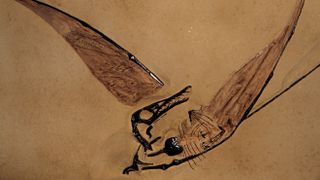'Flying dragon' fossil found preserved inside a rock in the Chilean desert
This is the first time the creature has been found in the Southern Hemisphere.

Scientists have identified the fossilized remains of a winged lizard unearthed in Chile’s Atacama Desert as a "flying dragon" — the first of its kind to be discovered in the Southern Hemisphere.
The pterosaur, which soared the skies 160 million years ago, had a wingspan of 6.5 feet (2 meters); a long, pointy tail; and outward-jutting teeth — features that give the Jurassic-era creature its fearsome "dragon" nickname.
Although the exact genus and species of the winged lizard are unknown, scientists think it is a member of Rhamphorhynchinae, a subfamily of rhamphorhynchoids, which were one of the two major types of pterosaurs (alongside pterodactyloids).
Related: Photos of pterosaurs: Flight in the age of dinosaurs
Compared with pterodactyloids, such as the genus of pteranodons that included species with wingspans over 23 feet (7 meters), Rhamphorhynchinae were on average smaller, sported longer tails and, instead of beaks, possessed fully toothed jaws, which they likely used to snatch fish and small marine mammals from the sea. The discovery is the first time a member of the Rhamphorhynchinae subfamily has been found below the equator.
"This discovery was very exciting," Jhonatan Alarcón, a University of Chile scientist who led the investigation, told Live Science in an email translated from Spanish. "We're the first paleontologists to reveal the presence of the subfamily Rhamphorhynchinae in the Southern Hemisphere. Before this discovery, it was thought that these pterosaurs had not existed at these latitudes."
Osvaldo Rojas, director of the Atacama Desert Museum of Natural History, discovered the fossil in 2009, Alarcón said. Rojas split open a desert rock that intrigued him and found the long-fossilized bones of the ancient reptile preserved inside. An analysis by Alarcón revealed that the ancient remains belonged to an unknown species in the Rhamphorhynchinae subfamily.
Sign up for the Live Science daily newsletter now
Get the world’s most fascinating discoveries delivered straight to your inbox.
How the reptile's remains ended up so far south, in northern Chile, resting atop the sands of the driest place on Earth, is open to speculation. For now, Alarcón said, "We can't say that this pterosaur is a migratory species," but the discovery does suggest that at least one member of Rhamphorhynchinae was dispersed from the Northern Hemisphere to the Southern Hemisphere.
When the ancient winged lizard was alive, most of the landmass of the Southern Hemisphere was part of a supercontinent called Gondwana, which formed after the larger supercontinent Pangaea cracked in two. Alarcón speculated that Chile's flying dragon could have drifted southward from the northern supercontinent of Laurasia to Gondwana. Because some members of Rhamphorhynchinae have also been found along the coast of modern-day Cuba, Chile’s dragon could have followed the coast south.
It "probably followed the coastline so that it didn't get too far away from its food," he said.
The researchers' next steps will be to carefully extract the final parts of the fossil that remain trapped inside the rock.
Then, they plan to make further comparisons between their pterosaur and others in the same subfamily. They hope that by doing so, they'll be able to figure out if the pterosaur is a completely new species.
The findings were published Sept. 6 in the journal Acta Palaeontologica Polonica.
Originally published on Live Science.

Ben Turner is a U.K. based staff writer at Live Science. He covers physics and astronomy, among other topics like tech and climate change. He graduated from University College London with a degree in particle physics before training as a journalist. When he's not writing, Ben enjoys reading literature, playing the guitar and embarrassing himself with chess.
